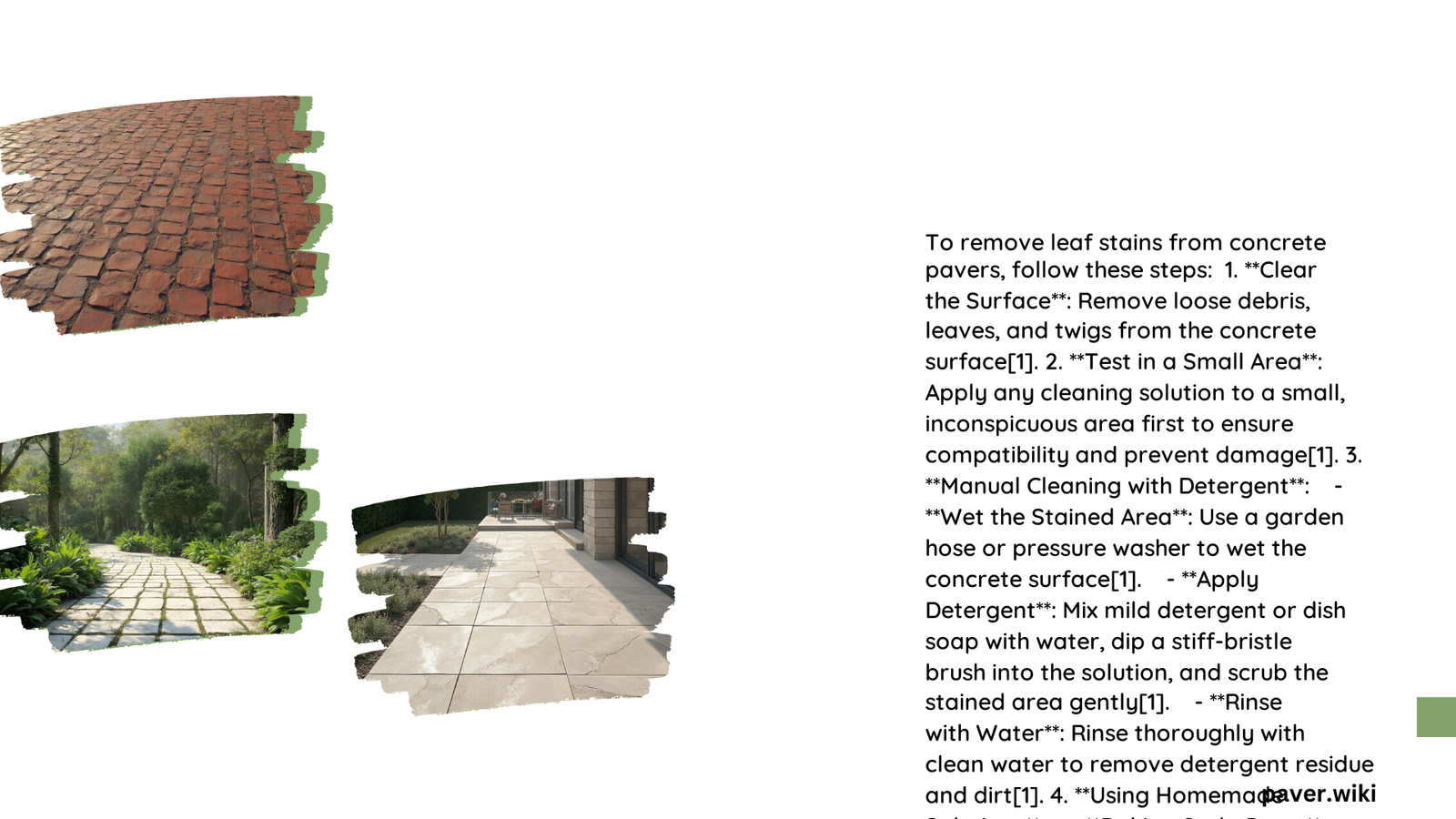Removing leaf stains from concrete pavers is a common challenge for homeowners and property managers. These stains, caused by tannins in decomposing leaves, can be stubborn and unsightly. This comprehensive guide explores various methods, from DIY solutions to commercial products, for effectively removing leaf stains from concrete pavers. We’ll cover step-by-step techniques, common challenges, and cost estimates to help you restore your pavers to their original beauty.
What Causes Leaf Stains on Concrete Pavers?
Leaf stains on concrete pavers are primarily caused by tannins, which are natural compounds found in leaves. When leaves fall and decompose on paver surfaces, these tannins leach out and can penetrate the porous surface of concrete pavers, leaving behind dark, stubborn stains. Factors that contribute to the severity of leaf stains include:
- Moisture levels
- Duration of leaf contact with the surface
- Type of leaves (some contain more tannins than others)
- Porosity of the paver surface
What Are the Most Effective DIY Methods for Removing Leaf Stains?

Several DIY methods can be effective for removing leaf stains from concrete pavers:
- Baking Soda Paste
- Mix baking soda with water to form a paste
- Apply to stained areas and let sit for 15-30 minutes
- Scrub with a stiff-bristle brush
-
Rinse thoroughly with clean water
-
Vinegar Solution
- Combine equal parts white vinegar and water
- Spray onto stained areas and let sit for 10-15 minutes
- Scrub with a brush
-
Rinse well with water
-
Bleach and Laundry Detergent Mixture
- Mix 16 parts bleach, 16 parts water, and 1 part liquid laundry detergent
- Apply to stains, let sit briefly
- Scrub with a brush
- Rinse thoroughly
How Do Commercial Cleaners Compare to DIY Solutions?
Commercial cleaners can be more potent and effective than DIY solutions, especially for stubborn stains. Here’s a comparison:
| Aspect | DIY Solutions | Commercial Cleaners |
|---|---|---|
| Cost | Generally lower | Higher initial investment |
| Effectiveness | Varies, may require multiple applications | Often more effective, especially for tough stains |
| Ease of Use | Simple to mix and apply | Ready to use, may require dilution |
| Safety | Generally safer, uses household items | May contain stronger chemicals, requires careful handling |
| Versatility | Limited to specific ingredients | Often suitable for multiple types of stains |
Popular commercial cleaners for leaf stain removal include:
- Active Plus™: A concentrated cleaner, deodorizer, and stain remover
- Simple Green Oxy: An oxygenated cleaner effective on various surfaces
What Steps Should Be Followed for Manual Cleaning with Detergent?
- Clear the surface of debris
- Wet the stained area with a garden hose
- Mix mild detergent or dish soap with water according to instructions
- Apply the solution to stained areas
- Scrub gently with a stiff-bristle brush
- Rinse thoroughly with clean water
How Can Baking Soda Be Used Effectively for Stain Removal?
Baking soda is an excellent natural cleaner for leaf stains. Here’s how to use it:
- Create a paste by mixing baking soda with water
- Apply the paste generously to stained areas
- Allow it to sit for 15-30 minutes
- Scrub the area with a stiff-bristle brush
- Rinse completely with clean water
- Repeat if necessary for stubborn stains
What Precautions Should Be Taken When Using Bleach-Based Solutions?
When using bleach-based solutions for leaf stain removal:
- Wear protective gear (gloves, eye protection)
- Ensure proper ventilation in the work area
- Test on a small, inconspicuous area first
- Avoid contact with plants or grass
- Never mix bleach with other cleaning products
- Rinse the area thoroughly after cleaning
How Do Environmental Factors Affect Stain Removal Effectiveness?
Several environmental factors can impact the effectiveness of leaf stain removal:
- Temperature: Ideal cleaning temperature is between 4°C and 32°C
- Sunlight: Direct sunlight can cause cleaning solutions to dry too quickly
- Humidity: High humidity may slow drying time and affect cleaning efficiency
- Season: Fall and winter may require more frequent cleaning due to increased leaf fall
What Are the Estimated Costs for Different Stain Removal Treatments?
Cost estimates for various stain removal treatments:
- DIY Solutions:
- Baking soda: $1-$2 per pound
- White vinegar: $1-$2 per gallon
- Bleach: $2-$5 per gallon
-
Liquid laundry detergent: $5-$10 per bottle
-
Commercial Cleaners:
- Active Plus™: $50-$100 for a 5kg container
- Simple Green Oxy: $20-$30 for a 1-gallon bottle
How Can Future Leaf Stains Be Prevented?
To prevent future leaf stains on concrete pavers:
- Regular sweeping or blowing of leaves
- Prompt removal of fallen leaves, especially when wet
- Application of a quality paver sealer
- Installation of proper drainage to prevent water pooling
- Regular cleaning and maintenance of paver surfaces
By following these methods and tips, you can effectively remove leaf stains from your concrete pavers and maintain their appearance for years to come.
References:
1. Sealers Plus: How To Clean and Remove Leaf Stains from Stone, Tile, Pavers & Concrete
2. Sudlow Concrete: A Guide to Removing Leaf Stains from Concrete Surfaces
3. Unilock: How To Remove Leaf Stains From Pavers
